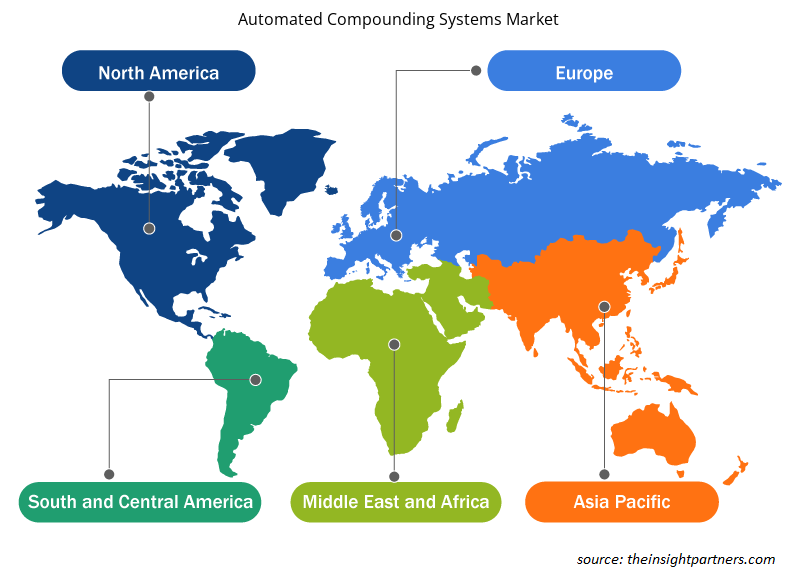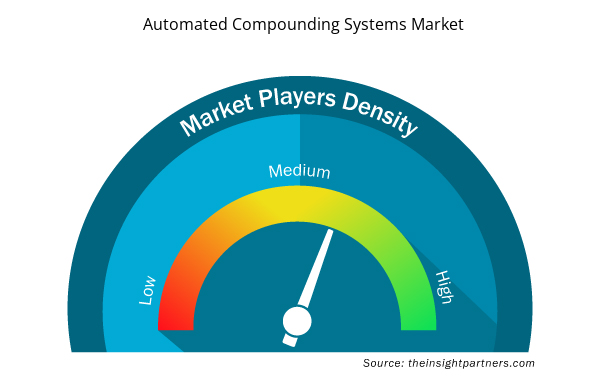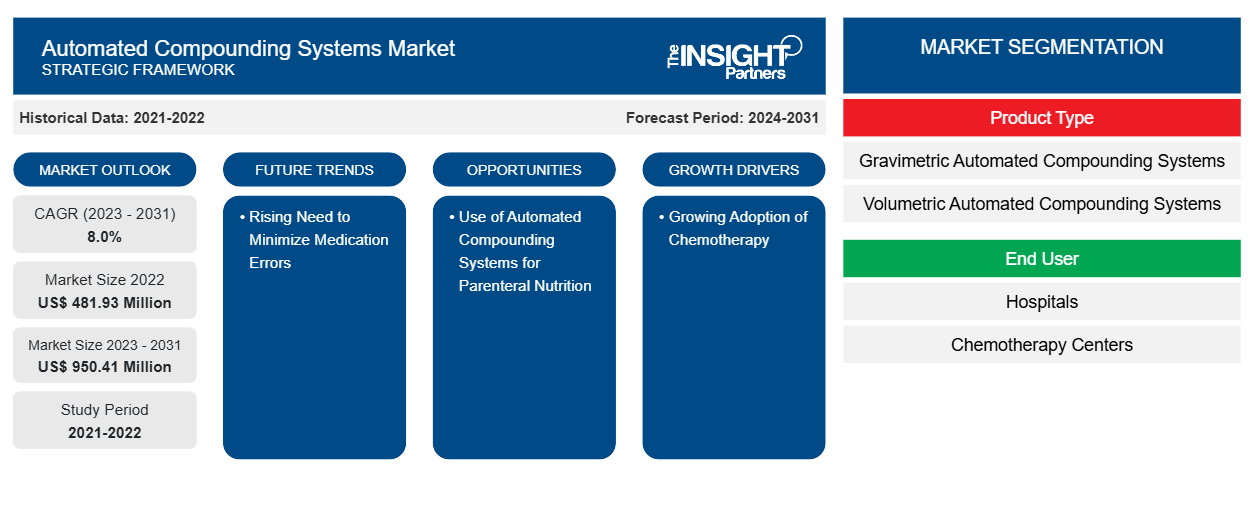Die Größe des Marktes für automatisierte Compounding-Systeme wurde auf 481,93 Millionen US-Dollar im Jahr 2022 und XX Millionen US-Dollar im Jahr 2023 geschätzt und soll bis 2031 950,41 Millionen US-Dollar erreichen; bis 2031 wird eine durchschnittliche jährliche Wachstumsrate (CAGR) von 8,0 % erwartet. Strategische Entwicklungen und Produkteinführungen werden voraussichtlich weiterhin wichtige Trends auf dem Markt für automatisierte Compounding-Systeme bleiben.CAGR of 8.0% till 2031. Strategic developments and product launches are likely to remain key Automated Compounding Systems Market trends.
Marktanalyse für automatisierte Compounding-Systeme
Die steigende Nachfrage nach personalisierten Medikamenten, verbesserte Patientensicherheit, strenge Vorschriften für die Arzneimittelherstellung, die Effizienz und Kosteneffizienz automatisierter Herstellungssysteme und das zunehmende Bewusstsein der Apotheker treiben das Wachstum des Marktes für automatisierte Herstellungssysteme voran. Darüber hinaus hat die zunehmende Verbreitung chronischer Krankheiten die Nachfrage nach automatisierten Herstellungssystemen angekurbelt.
Marktübersicht für automatisierte Compounding-Systeme
Automatisierte Mischsysteme helfen, Medikationsfehler zu vermeiden, die durch verschiedene Faktoren verursacht werden, wie etwa schlechte Kommunikation zwischen Arzt und Apotheker, kritische Lagerungspraktiken in Apotheken und Verwirrung, die durch die Verwendung ähnlicher Etiketten entsteht. Darüber hinaus haben sich mit den automatisierten Mischsystemen die Genauigkeit und Effizienz der Abgabe von Mischprodukten verbessert und die Belastung des medizinischen Personals mit toxischen Substanzen weiter reduziert.
Passen Sie diesen Bericht Ihren Anforderungen an
Sie erhalten kostenlos individuelle Anpassungen an jedem Bericht, einschließlich Teilen dieses Berichts oder einer Analyse auf Länderebene, eines Excel-Datenpakets sowie tolle Angebote und Rabatte für Start-ups und Universitäten.
- Holen Sie sich die wichtigsten Markttrends aus diesem Bericht.Dieses KOSTENLOSE Beispiel umfasst eine Datenanalyse von Markttrends bis hin zu Schätzungen und Prognosen.
Markttreiber und Chancen für automatisierte Compounding-Systeme
Steigender Bedarf zur Minimierung von Medikationsfehlern
Medikations- und Abgabefehler sind weltweit die Hauptursachen für Krankenhauswiederaufnahmen. Medikationsfehler können sowohl von medizinischem als auch von paramedizinischem Personal auf zahlreichen Ebenen der Patientenversorgung begangen werden. Ein Medikationsfehler kann aufgrund verschiedener Faktoren auftreten, beispielsweise aufgrund einer schlechten Kommunikation zwischen Arzt und Apotheker, gefährlicher Lagerungspraktiken in Apotheken und Missverständnissen aufgrund der Verwendung derselben Etiketten. Daher ist eine mehrstufige Überwachung obligatorisch. Automatisierte Mischsysteme gelten als eine der geeignetsten Lösungen zur Verringerung dieser Fehler. Verschiedene Regierungsorganisationen arbeiten an Maßnahmen zur Vermeidung von Medikationsfehlern und entwickeln Methoden und Systeme zur Überwindung dieser Fehler, um den Patienten die richtigen Medikamente zu geben. Um Medikations- und Mischfehler zu minimieren, fördern Regierungen in mehreren Ländern den Einsatz automatisierter Misch- und Medikationswerkzeuge in Apotheken und Krankenhäusern. Dies gilt als ein wichtiger Faktor, der das Wachstum des Marktes für automatisierte Mischsysteme vorantreibt.readmissions across the world. Medication errors can happen by both medical and paramedical personnel at numerous levels of patient care. A medication error can happen due to several factors such as poor order communication between the doctor and pharmacist, hazardous storage practices in drugstores, and misunderstanding raised due to the usage of the same labels. Hence, multilevel monitoring is compulsory. Automated compounding systems are deliberated to be one of the most qualified solutions to diminish these errors. Various government organizations are working on the measures to avoid medication errors and developing methods and systems to overcome these errors in order to provide proper medication to the patients. Thus, to minimize medication and compounding errors, governments in several nations are encouraging the use of automated compounding and medication tools in pharmacies and hospitals. This is considered to be a major factor propelling the growth of automated compounding systems market.
Einsatz automatisierter Compounding-Systeme für die parenterale Ernährung – eine Chance für den Markt für automatisierte Compounding-SystemeParenteral Nutrition – An Opportunity of Automated Compounding Systems Market
Parenterale Ernährung ist angezeigt, wenn Patienten aufgrund von Krankheiten wie Krebs und chronischen Erkrankungen des Magen-Darm-Trakts ihren nutrition is indicated when patients cannot meet their Nährstoffbedarf nicht decken können . Diese Art der Ernährung ist der Eckpfeiler der Therapie für die meisten Patienten mit schwerem Kurzdarmsyndrom (SBS). SBS tritt jährlich bei etwa 3 von 1 Million Menschen auf. Laut dem 2020 veröffentlichten Artikel „Understanding Short Bowel Syndrome: Current Status and Future Perspectives“ hat sich die Prävalenz von SBS in den letzten 40 Jahren mehr als verdoppelt. Die Prävalenz betrug in den USA etwa 30 Fälle pro Million und in Europa etwa 1,4 Fälle pro Million. Zur Herstellung von parenteralen Ernährungsprodukten können automatisierte Mischsysteme verwendet werden. Die automatisierten Mischsysteme sind normalerweise mit einer speziellen Software verbunden, die Informationen über PN-Formulierungen elektronisch überträgt. Eine Reihe von Forschern vergleichen die PN-Formulierungen, die mit automatisierten Mischsystemen und mit manuellen Methoden hergestellt wurden. Die laufenden Forschungen zur Verwendung automatisierter Mischsysteme zur Formulierung von PN werden voraussichtlich Wachstumschancen für den Markt für automatisierte Mischsysteme schaffen.SBS). SBS occurs in ~3 per 1 million people yearly. As per the article titled “Understanding Short Bowel Syndrome: Current Status and Future Perspectives," published in 2020, the prevalence of SBS has increased by more than twofold in the last 40 years. The prevalence was ~30 cases per million in the US and approximately 1.4 cases per million in Europe. Automated compounding systems can be used to manufacture parenteral nutrition products. The automated compounding systems is usually linked to dedicated software that electronically transfers information about PN formulations. A number of researchers are comparing the PN formulations prepared by automated compounding systems and by manual methods. The ongoing researches for use of automated compounding systems for formulation of PN is expected to create opportunity for growth of automated compounding systems market.
Segmentierungsanalyse des Marktberichts für automatisierte Compounding-Systeme
Wichtige Segmente, die zur Ableitung der Marktanalyse für automatisierte Compounding-Systeme beigetragen haben, sind Verabreichungsweg, Anwendung und Endbenutzer.
- Basierend auf dem Produkttyp ist der Markt für automatisierte Compounding-Systeme in gravimetrische automatisierte Compounding-Systeme und volumetrische automatisierte Compounding-Systeme unterteilt. Das Segment der gravimetrischen automatisierten Compounding-Systeme hatte im Jahr 2023 den größten Marktanteil.
- Nach Endbenutzer ist der Markt für automatisierte Compounding-Systeme in Krankenhäuser, Chemotherapiezentren und andere unterteilt. Das Krankenhaussegment hatte im Jahr 2023 den größten Marktanteil.
Automatisierte Compounding-Systeme Marktanteilsanalyse nach Geografie
Der geografische Umfang des Marktberichts über automatisierte Compounding-Systeme ist hauptsächlich in fünf Regionen unterteilt: Nordamerika, Asien-Pazifik, Europa, Naher Osten und Afrika sowie Süd- und Mittelamerika.
Nordamerika dominiert den Markt für automatisierte Compounding-Systeme. Das Marktwachstum in Nordamerika ist gekennzeichnet durch eine erhöhte Nachfrage nach Medikamenten gegen chronische Krankheiten, die Präsenz wichtiger Marktteilnehmer, eine Zunahme von Produkteinführungen, die zunehmende Einführung automatisierter Compounding-Systeme in den USA, eine steigende Arzneimittelproduktion, die zu einer steigenden Nachfrage nach automatisierter Abfüllung und Verpackung von Arzneimitteln führt, sowie umfangreiche F&E-Aktivitäten von akademischen und Forschungsinstituten und Pharmaunternehmen. Darüber hinaus wird erwartet, dass der asiatisch-pazifische Raum in den kommenden Jahren die höchste durchschnittliche jährliche Wachstumsrate verzeichnen wird.
Regionale Einblicke in den Markt für automatisierte Compounding-Systeme
Die regionalen Trends und Faktoren, die den Markt für automatisierte Compounding-Systeme während des gesamten Prognosezeitraums beeinflussen, wurden von den Analysten von Insight Partners ausführlich erläutert. In diesem Abschnitt werden auch die Marktsegmente und die Geografie für automatisierte Compounding-Systeme in Nordamerika, Europa, im asiatisch-pazifischen Raum, im Nahen Osten und Afrika sowie in Süd- und Mittelamerika erörtert.

- Erhalten Sie regionale Daten zum Markt für automatisierte Compounding-Systeme
Umfang des Marktberichts zu automatisierten Compounding-Systemen
| Berichtsattribut | Details |
|---|---|
| Marktgröße im Jahr 2022 | 481,93 Millionen US-Dollar |
| Marktgröße bis 2031 | 950,41 Millionen US-Dollar |
| Globale CAGR (2023 - 2031) | 8,0 % |
| Historische Daten | 2021-2022 |
| Prognosezeitraum | 2024–2031 |
| Abgedeckte Segmente | Nach Produkttyp
|
| Abgedeckte Regionen und Länder | Nordamerika
|
| Marktführer und wichtige Unternehmensprofile |
|
Dichte der Marktteilnehmer für automatisierte Compounding-Systeme: Auswirkungen auf die Geschäftsdynamik verstehen
Der Markt für automatisierte Compounding-Systeme wächst rasant, angetrieben durch die steigende Nachfrage der Endnutzer aufgrund von Faktoren wie sich entwickelnden Verbraucherpräferenzen, technologischen Fortschritten und einem größeren Bewusstsein für die Vorteile des Produkts. Mit steigender Nachfrage erweitern Unternehmen ihr Angebot, entwickeln Innovationen, um die Bedürfnisse der Verbraucher zu erfüllen, und nutzen neue Trends, was das Marktwachstum weiter ankurbelt.
Die Marktteilnehmerdichte bezieht sich auf die Verteilung der Firmen oder Unternehmen, die in einem bestimmten Markt oder einer bestimmten Branche tätig sind. Sie gibt an, wie viele Wettbewerber (Marktteilnehmer) in einem bestimmten Marktraum im Verhältnis zu seiner Größe oder seinem gesamten Marktwert präsent sind.
Die wichtigsten auf dem Markt für automatisierte Compounding-Systeme tätigen Unternehmen sind:
- Simplvia
- Baxter International Inc.
- Braun Melsungen AG
- Komm schon
- ICU MEDICAL INC
- Grifols, SA
Haftungsausschluss : Die oben aufgeführten Unternehmen sind nicht in einer bestimmten Reihenfolge aufgeführt.

- Erhalten Sie einen Überblick über die wichtigsten Akteure auf dem Markt für automatisierte Compounding-Systeme
Marktnachrichten und aktuelle Entwicklungen zu automatisierten Compounding-Systemen
Der Markt für automatisierte Compounding-Systeme wird durch die Erfassung qualitativer und quantitativer Daten nach Primär- und Sekundärforschung bewertet, die wichtige Unternehmensveröffentlichungen, Verbandsdaten und Datenbanken umfasst. Im Folgenden finden Sie eine Liste der Entwicklungen auf dem Markt für automatisierte Compounding-Systeme und -Strategien:
- Simplivia hat die innovative Chemo-Automatisierungslösung SmartCompounders auf den Markt gebracht, die auf dem führenden Chemfort Closed System Drug-Transfer Device (CSTD) basiert. Sie gibt Apothekern und Technikern die Werkzeuge an die Hand, um den Compounding-Prozess kürzer und zuverlässiger zu gestalten und Fehler bei der Medikamentenidentifikation und Dosierungsmenge auszuschließen. (Quelle: Simplivia, Unternehmenswebsite, 2024)
- Baxter International Inc hat den ExactaMix Pro Automated Compounder auf den Markt gebracht. ExactaMix Pro kombiniert im Vergleich zu ExactaMix verbesserte Sicherheit mit intuitiveren und effizienteren Funktionen und einer höheren Verarbeitungsleistung. (Quelle: Baxter, Unternehmenswebsite, 2022)
Marktbericht zu automatisierten Compounding-Systemen – Umfang und Ergebnisse
Der Bericht „Marktgröße und Prognose für automatisierte Compounding-Systeme (2021–2031)“ bietet eine detaillierte Analyse des Marktes, die die folgenden Bereiche abdeckt:
- Marktgröße und Prognose auf globaler, regionaler und Länderebene für alle wichtigen Marktsegmente, die im Rahmen des Projekts abgedeckt sind
- Marktdynamik wie Treiber, Beschränkungen und wichtige Chancen
- Wichtige Zukunftstrends
- Detaillierte PEST/Porters Five Forces- und SWOT-Analyse
- Globale und regionale Marktanalyse mit wichtigen Markttrends, wichtigen Akteuren, Vorschriften und aktuellen Marktentwicklungen
- Branchenlandschaft und Wettbewerbsanalyse, einschließlich Marktkonzentration, Heatmap-Analyse, prominenten Akteuren und aktuellen Entwicklungen
- Detaillierte Firmenprofile
- Historische Analyse (2 Jahre), Basisjahr, Prognose (7 Jahre) mit CAGR
- PEST- und SWOT-Analyse
- Marktgröße Wert/Volumen – Global, Regional, Land
- Branche und Wettbewerbsumfeld
- Excel-Datensatz



Report Coverage
Revenue forecast, Company Analysis, Industry landscape, Growth factors, and Trends

Segment Covered
This text is related
to segments covered.

Regional Scope
North America, Europe, Asia Pacific, Middle East & Africa, South & Central America

Country Scope
This text is related
to country scope.
Trends and growth analysis reports related to Life Sciences : READ MORE..
The Insight Partners performs research in 4 major stages: Data Collection & Secondary Research, Primary Research, Data Analysis and Data Triangulation & Final Review.
- Data Collection and Secondary Research:
As a market research and consulting firm operating from a decade, we have published and advised several client across the globe. First step for any study will start with an assessment of currently available data and insights from existing reports. Further, historical and current market information is collected from Investor Presentations, Annual Reports, SEC Filings, etc., and other information related to company’s performance and market positioning are gathered from Paid Databases (Factiva, Hoovers, and Reuters) and various other publications available in public domain.
Several associations trade associates, technical forums, institutes, societies and organization are accessed to gain technical as well as market related insights through their publications such as research papers, blogs and press releases related to the studies are referred to get cues about the market. Further, white papers, journals, magazines, and other news articles published in last 3 years are scrutinized and analyzed to understand the current market trends.
- Primary Research:
The primarily interview analysis comprise of data obtained from industry participants interview and answers to survey questions gathered by in-house primary team.
For primary research, interviews are conducted with industry experts/CEOs/Marketing Managers/VPs/Subject Matter Experts from both demand and supply side to get a 360-degree view of the market. The primary team conducts several interviews based on the complexity of the markets to understand the various market trends and dynamics which makes research more credible and precise.
A typical research interview fulfils the following functions:
- Provides first-hand information on the market size, market trends, growth trends, competitive landscape, and outlook
- Validates and strengthens in-house secondary research findings
- Develops the analysis team’s expertise and market understanding
Primary research involves email interactions and telephone interviews for each market, category, segment, and sub-segment across geographies. The participants who typically take part in such a process include, but are not limited to:
- Industry participants: VPs, business development managers, market intelligence managers and national sales managers
- Outside experts: Valuation experts, research analysts and key opinion leaders specializing in the electronics and semiconductor industry.
Below is the breakup of our primary respondents by company, designation, and region:

Once we receive the confirmation from primary research sources or primary respondents, we finalize the base year market estimation and forecast the data as per the macroeconomic and microeconomic factors assessed during data collection.
- Data Analysis:
Once data is validated through both secondary as well as primary respondents, we finalize the market estimations by hypothesis formulation and factor analysis at regional and country level.
- Macro-Economic Factor Analysis:
We analyse macroeconomic indicators such the gross domestic product (GDP), increase in the demand for goods and services across industries, technological advancement, regional economic growth, governmental policies, the influence of COVID-19, PEST analysis, and other aspects. This analysis aids in setting benchmarks for various nations/regions and approximating market splits. Additionally, the general trend of the aforementioned components aid in determining the market's development possibilities.
- Country Level Data:
Various factors that are especially aligned to the country are taken into account to determine the market size for a certain area and country, including the presence of vendors, such as headquarters and offices, the country's GDP, demand patterns, and industry growth. To comprehend the market dynamics for the nation, a number of growth variables, inhibitors, application areas, and current market trends are researched. The aforementioned elements aid in determining the country's overall market's growth potential.
- Company Profile:
The “Table of Contents” is formulated by listing and analyzing more than 25 - 30 companies operating in the market ecosystem across geographies. However, we profile only 10 companies as a standard practice in our syndicate reports. These 10 companies comprise leading, emerging, and regional players. Nonetheless, our analysis is not restricted to the 10 listed companies, we also analyze other companies present in the market to develop a holistic view and understand the prevailing trends. The “Company Profiles” section in the report covers key facts, business description, products & services, financial information, SWOT analysis, and key developments. The financial information presented is extracted from the annual reports and official documents of the publicly listed companies. Upon collecting the information for the sections of respective companies, we verify them via various primary sources and then compile the data in respective company profiles. The company level information helps us in deriving the base number as well as in forecasting the market size.
- Developing Base Number:
Aggregation of sales statistics (2020-2022) and macro-economic factor, and other secondary and primary research insights are utilized to arrive at base number and related market shares for 2022. The data gaps are identified in this step and relevant market data is analyzed, collected from paid primary interviews or databases. On finalizing the base year market size, forecasts are developed on the basis of macro-economic, industry and market growth factors and company level analysis.
- Data Triangulation and Final Review:
The market findings and base year market size calculations are validated from supply as well as demand side. Demand side validations are based on macro-economic factor analysis and benchmarks for respective regions and countries. In case of supply side validations, revenues of major companies are estimated (in case not available) based on industry benchmark, approximate number of employees, product portfolio, and primary interviews revenues are gathered. Further revenue from target product/service segment is assessed to avoid overshooting of market statistics. In case of heavy deviations between supply and demand side values, all thes steps are repeated to achieve synchronization.
We follow an iterative model, wherein we share our research findings with Subject Matter Experts (SME’s) and Key Opinion Leaders (KOLs) until consensus view of the market is not formulated – this model negates any drastic deviation in the opinions of experts. Only validated and universally acceptable research findings are quoted in our reports.
We have important check points that we use to validate our research findings – which we call – data triangulation, where we validate the information, we generate from secondary sources with primary interviews and then we re-validate with our internal data bases and Subject matter experts. This comprehensive model enables us to deliver high quality, reliable data in shortest possible time.


 Holen Sie sich ein kostenloses Muster für diesen Bericht
Holen Sie sich ein kostenloses Muster für diesen Bericht